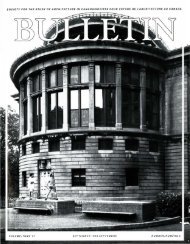CANADA - SEXTONdigital
CANADA - SEXTONdigital
CANADA - SEXTONdigital
You also want an ePaper? Increase the reach of your titles
YUMPU automatically turns print PDFs into web optimized ePapers that Google loves.
J ULIAN S MITH > ESSAY I ESSAI<br />
. ) j<br />
FIG . 5. DETERIORATION OF THE MONUMENT BEFORE<br />
RESTORATION. THE CONTINUITY OF THE SURFACE<br />
IS DISRUPTED BY BOTH SURFACE DECAY AND<br />
DISCOLOURATION OF THE MORTAR JOINTS.<br />
CRACKING AND SPALLING ERODE THE SIMPLICITY<br />
OF THE DESIGN. THE LATER WHITE LIMESTONE<br />
PAVING UNDERMINES ALLWARD'S JUXTAPOSITION<br />
OF THE FORMAL PURITY OF THE MONUMENT WITH<br />
HAUNTING SIMPLICITY AND INFORMALITY OF A<br />
DARKER LANDSCAPE. ! CA81N£TLEF!vRE. MAY 2003.<br />
I -- -------<br />
FIG . 6. DETERIORATION OF THE MONUMENT BEFORE RESTORATION. THE SURFACE OF THE MONUMENT HAD BEEN<br />
BROKEN UP BY A PATCHWORK OF DIFFERENT STONE TYPES, TYPOGRAPHICAL STYLES, CALCITE DEPOSITS, SURFACE<br />
DISCOLOURATIONS, AND SPALLING. I CABIN£1 UF!vRE. MAY 2003.<br />
remove, as much as possible, the slight<br />
discolorations which had begun to create<br />
local variations and to distinguish individual<br />
stones within the larger composition.<br />
His obsession with the formal purity of<br />
the monument was thus carried through<br />
right to the time of dedication. The many<br />
thousands of visitors who assembled for<br />
the opening found a monument of enormous<br />
beauty and emotional power, and<br />
it seems that Allward had succeeded in<br />
his mission.<br />
Time was not kind to Allward, however,<br />
or to his monument. By the end<br />
of the century, the monument was selfdestructing<br />
and a long history of repairs<br />
had left a patchwork of materials, col <br />
ours and textures, and a disconcerting<br />
pattern of joints and inserts (figs. 5, 6).<br />
The challenge, in terms of restoring the<br />
monument, was to find an approach<br />
that would respect Allward's intentions,<br />
and would return some kind of integrity<br />
to the monument. The answers could<br />
not be found by simply intensifying the<br />
decision making. The photograph, for<br />
example, has become a document frequently<br />
used in conservation to establish<br />
historical fact and to guide restoration<br />
activity. It is assumed that a photograph<br />
provides an unbiased perspective on<br />
what existed at some point in time, or<br />
what survives today. Similarly, detailed<br />
measured drawings are used as valuefree<br />
documents representing the reality<br />
of what exists. They become the basis<br />
for the working drawings of conserva-<br />
tion activity.<br />
The problem is that restoration is a<br />
process that plays around with cultural<br />
value, and that makes decisions<br />
about cultural continuity and cultural<br />
disruption. People react viscerally to<br />
restoration projects because their own<br />
values are often embedded in the object<br />
in question, and they can easily<br />
sense whether those values are being<br />
celebrated, ignored, or even trampled<br />
on. Photographs and measured drawings<br />
may be unbiased, but often bias<br />
technical research. Although deterioration<br />
is usually a technical issue, appropriate<br />
conservation solutions first have<br />
to be defined philosophically.<br />
In the case of Vimy, its situation within<br />
the larger context of post-war cultural upheaval<br />
had not been studied when the<br />
project brief was issued . It was Jacqueline<br />
Hucker who provided the restoration<br />
team with the first careful study of Allward's<br />
work in the context of the early<br />
twentieth century, and who was able to<br />
provide a framework for understanding<br />
the observable physical reality. The research<br />
findings allowed the monument<br />
to be appreciated as the representation<br />
of an idea . The conservation options<br />
could then be discussed in terms of their<br />
appropriateness to that idea. How best<br />
could one conserve the ideas intrinsic to<br />
the values of the site?<br />
This issue of representation is central to<br />
the activity of conservation, and yet is<br />
not well understood as a framework for<br />
52<br />
JSSAC I JSEAC 33 > N• 1 > 2008
















